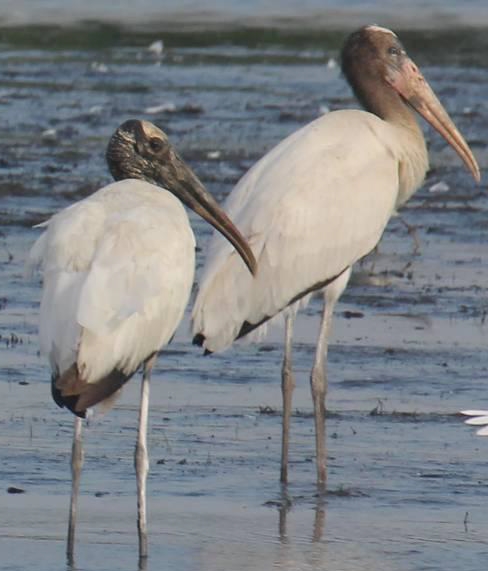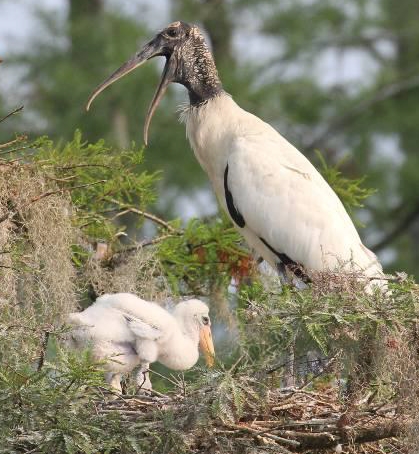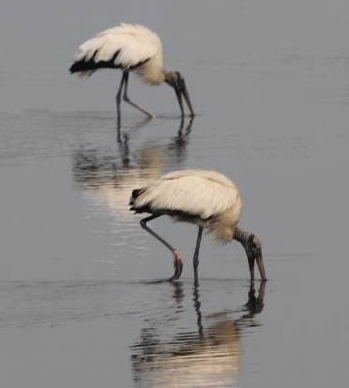Wildlife - Species

Status in SC: Threatened
Wood Stork
The status of the Wood Stork was reviewed by the US Fish and Wildlife Service (USFWS) in 2007, and in 2010, a petition was filed to reclassify Wood Storks as Threatened rather than Endangered (USFWS 2010). A decision on the reclassification was announced in June 2014 and the bird was down-listed to Threatened.


Wood Stork (Mycteria americana)
Description
Wood storks are some of the largest wading birds inhabiting South Carolina. They stand over 1 meter tall, and their wingspan is over 150 cm (60 in). The bird's body is white with black flight feathers (on the edges of the wings) and tail. Its head and neck are bare and of a dark gray color, a fact that has earned the wood stork the name "flinthead." Adults have a dark gray beak that is long and slightly curved. Young storks have dull yellow beaks. Unlike other wading birds such as herons, storks extend their necks during flight. Their reputation as magnificent fliers is well established. Wood storks are not very vocal birds, except when they are around their nest; adults make low croaking sounds, and young make rattling noises with their beaks.
Preferred Habitat and Biology
Wood storks are distributed from South Carolina to southern South America. In the United States, wood storks concentrate on coastal areas of Florida, Georgia, and South Carolina. They are the only species of stork that resides in the United States. After the breeding season, wood storks can be found throughout the Southeastern Coastal Plain. They have been reported as far west as California and as far north as Massachusetts. In South Carolina, wood storks nest in four counties, including Colleton County. Three nesting colonies are found within the boundaries of the ACE Basin study area. Nests are typically located on trees surrounded by water, such as in cypress swamps, shallow creeks, and impoundments. An average of three eggs is laid, and the parents take turns incubating them for about 30 days. Hatchlings then remain in the nest for approximately 55 days. As of the summer of 1997, the nesting population of wood storks in the state was over 950 pairs. Wood storks form nesting colonies that may contain up to 10,000 nests. In South Carolina, the seven nesting colonies in existence contain an average of 102 nests. In the mid to late 1990s, five of these colonies were in the ACE Basin. These large wading birds are commonly seen walking slowly through the marshes in search of food. They dip their open beaks in shallow water and "feel around" for small fish or crustaceans. The daily food intake of an adult is about 1 pound of fish. When several birds feed in a pool, they typically shuffle their feet to stir fish out of their hiding places so they can be picked up by the other birds.
Species Significance
In the 1930s, wood storks were commonly found in all coastal areas from South Carolina to Texas. However, wood stork populations have declined drastically in recent times, primarily because of habitat alteration. The availability of suitable feeding areas has been reduced due to draining of wetlands, flood control practices, land development, and lumbering. In South Carolina, they were listed as endangered under the Nongame and Endangered Species Act of 1974. In 1984, wood storks were placed on the U. S. Endangered Species List.
References
Bull, J. L. and J. Farrand, Jr. 1995. National Audubon Society Field Guide to North American Birds. Eastern Region. The Audubon Society field guide series. Alfred A. Knopf Inc., New York, NY.
Dodd, M. G. and T. M. Murphy. 1997. The status and distribution of wading birds in South Carolina, 1988-1996. The Chat 61(3): 129-181.
Murphy, S. H. and G. Barnette (eds.). not dated. South Carolina's endangered species portfolio. South Carolina Department of Natural Resources, Wildlife Diversity Section, Columbia, SC.
Sprunt, A., Jr. and E. B. Chamberlain. 1970. South Carolina bird life. University of South Carolina Press, Columbia, SC.
